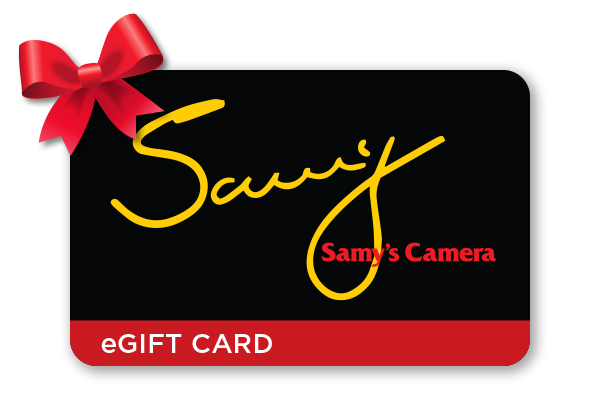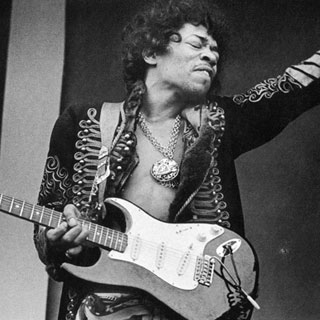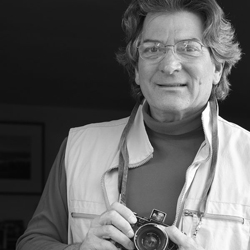It is difficult to write about a friend who has recently passed on. That is especially true if the friend happened to have been an extraordinary photographer; one of the greatest ever. He is someone 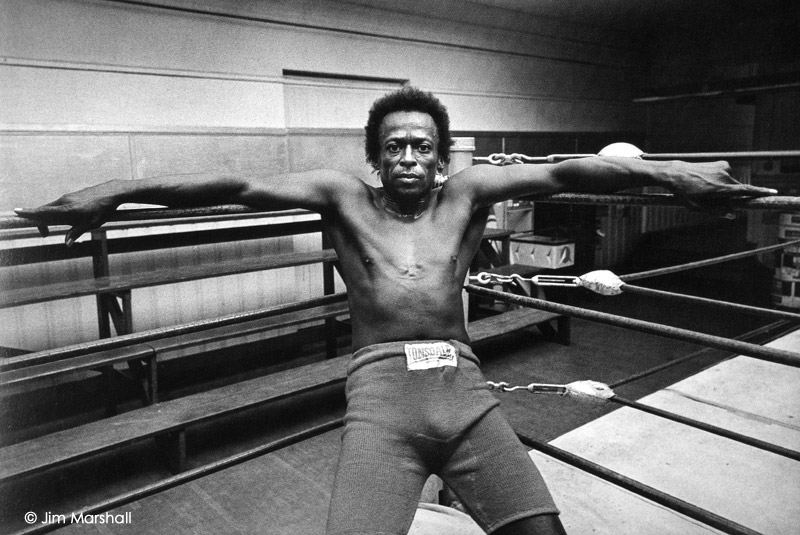 whose work helped to define an entire generation of musicians, as well as the tone and mood of America during the 1960's through the 21st century. Jim Marshall, the legendary rock 'n' roll photographer, was truly bigger than life.
Marshall was the real thing. He was an uncompromising photographer who brought an intense, sophisticated vision to his photographs. He had a deep respect for the people he photographed and the music they produced, whether it was the brilliant jazz musician Miles Davis, or our own generation's most prolific poet, Bob Dylan. His photographs of the British bands, the Beatles, the Rolling Stones and the Who are definitive and profoundly memorable. It is reported that he had over 500 album covers to his credit.
It is not widely known, but he also photographed the political hurricanes of the 1960's. He accomplished sensitive work documenting the Black Panthers and others involved in the civil rights movement of the early 1960's. He also photographed the poverty of rural Appalachia.
whose work helped to define an entire generation of musicians, as well as the tone and mood of America during the 1960's through the 21st century. Jim Marshall, the legendary rock 'n' roll photographer, was truly bigger than life.
Marshall was the real thing. He was an uncompromising photographer who brought an intense, sophisticated vision to his photographs. He had a deep respect for the people he photographed and the music they produced, whether it was the brilliant jazz musician Miles Davis, or our own generation's most prolific poet, Bob Dylan. His photographs of the British bands, the Beatles, the Rolling Stones and the Who are definitive and profoundly memorable. It is reported that he had over 500 album covers to his credit.
It is not widely known, but he also photographed the political hurricanes of the 1960's. He accomplished sensitive work documenting the Black Panthers and others involved in the civil rights movement of the early 1960's. He also photographed the poverty of rural Appalachia.
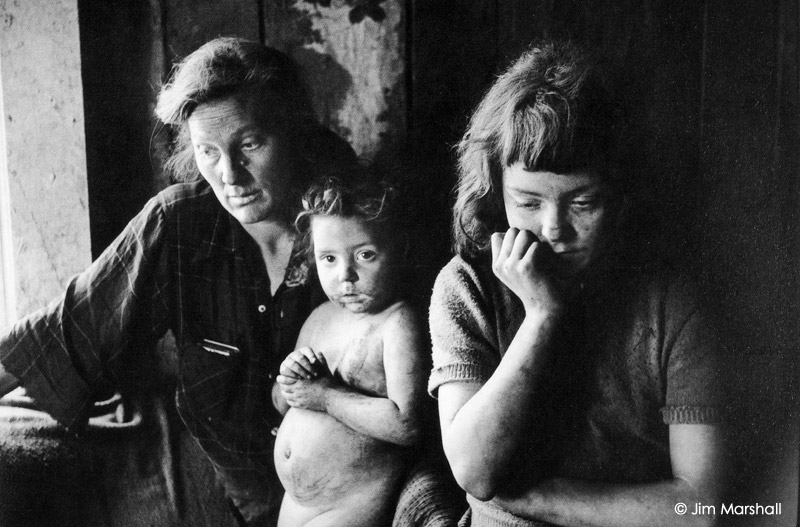 Jim Marshall passed away on March 24, 2010 in New York City, while promoting a new book. Sadly, we have lost another great photographer. He was from a generation of amazing film photographers, many whose work found expression in black and white film emulsions. Jim Marshall is gone, but he will never be forgotten. Marshall would say of his work that he thought of himself as a photojournalist. He requested, and almost always received, total access to the musicians he photographed. He never fashioned himself as a celebrity photographer, although he worked with some of the most famous, highly successful individuals in the music world. He was schooled in the down the line, black-and-white "moment of truth" as photographer Cartier Bresson would coin the classic phrase "The Decisive Moment".
With a highly focused eye, he photographed with Leica 35 mm film cameras, mostly shooting Tri-x film, carefully filling his frame the way a fine artist renders every inch of their composition to support their unique vision and purpose. He rarely cropped his photographs, believing instead in the power of the full-frame image. Technically, he was a master with 35mm black and white photography. Whether he was working in extreme low light levels with black jazz musicians, or bright sunlight, blazing on outdoor concert stages, his photographs were beautifully executed. He was demanding of his darkroom assistants; the ones who developed his film, made exquisite enlargements for exhibitions and provided images for the multitude of magazines and books in which his work would later appear.
Jim Marshall passed away on March 24, 2010 in New York City, while promoting a new book. Sadly, we have lost another great photographer. He was from a generation of amazing film photographers, many whose work found expression in black and white film emulsions. Jim Marshall is gone, but he will never be forgotten. Marshall would say of his work that he thought of himself as a photojournalist. He requested, and almost always received, total access to the musicians he photographed. He never fashioned himself as a celebrity photographer, although he worked with some of the most famous, highly successful individuals in the music world. He was schooled in the down the line, black-and-white "moment of truth" as photographer Cartier Bresson would coin the classic phrase "The Decisive Moment".
With a highly focused eye, he photographed with Leica 35 mm film cameras, mostly shooting Tri-x film, carefully filling his frame the way a fine artist renders every inch of their composition to support their unique vision and purpose. He rarely cropped his photographs, believing instead in the power of the full-frame image. Technically, he was a master with 35mm black and white photography. Whether he was working in extreme low light levels with black jazz musicians, or bright sunlight, blazing on outdoor concert stages, his photographs were beautifully executed. He was demanding of his darkroom assistants; the ones who developed his film, made exquisite enlargements for exhibitions and provided images for the multitude of magazines and books in which his work would later appear.
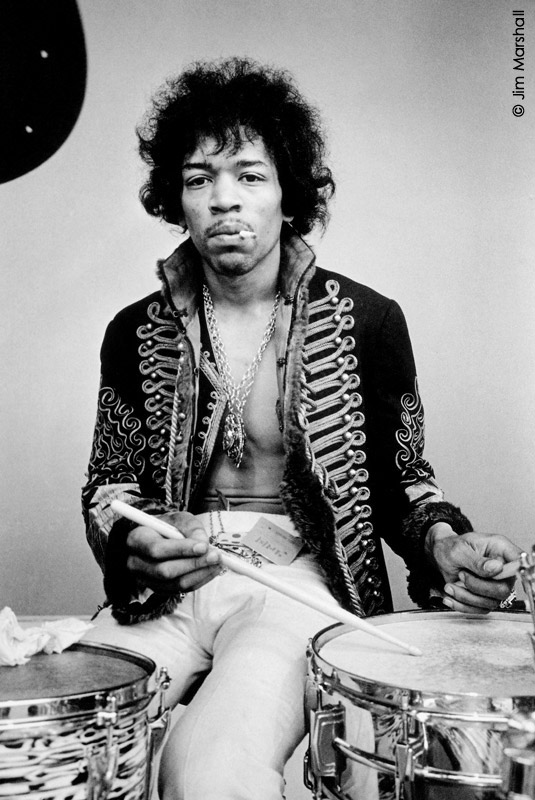 There's a story I heard once about Marshall before we met and became friends. I never forgot it. He had done a major shoot for a record company, including the key art used for the album cover and supporting back up images of the musicians. He was unhappy with how the art director was using his pictures. Marshall went into the art director's office, carrying a loaded handgun into the meeting with him. He told the art director that if he didn't use his photographs properly, his life hung in the balance.
Knowing Jim, I'm sure this was a passionate, dramatic, theatrical gesture on his part. He probably intended to emphasize how important it was to him that his pictures were respected, and that the designs brought out the best of their potential. Jim would never have actually fired his weapon, but the incident illustrates how emotionally connected he was to his work. It was paramount to him that a photographer had the right to have their work used with respect and integrity. He fought many battles to ensure that his photographs were properly used. He championed the concept that photographers should own their own work and maintain the copyright to their images, even when on assignment. He sued many people through his lifetime for publishing his photographs without his permission.
There's a story I heard once about Marshall before we met and became friends. I never forgot it. He had done a major shoot for a record company, including the key art used for the album cover and supporting back up images of the musicians. He was unhappy with how the art director was using his pictures. Marshall went into the art director's office, carrying a loaded handgun into the meeting with him. He told the art director that if he didn't use his photographs properly, his life hung in the balance.
Knowing Jim, I'm sure this was a passionate, dramatic, theatrical gesture on his part. He probably intended to emphasize how important it was to him that his pictures were respected, and that the designs brought out the best of their potential. Jim would never have actually fired his weapon, but the incident illustrates how emotionally connected he was to his work. It was paramount to him that a photographer had the right to have their work used with respect and integrity. He fought many battles to ensure that his photographs were properly used. He championed the concept that photographers should own their own work and maintain the copyright to their images, even when on assignment. He sued many people through his lifetime for publishing his photographs without his permission.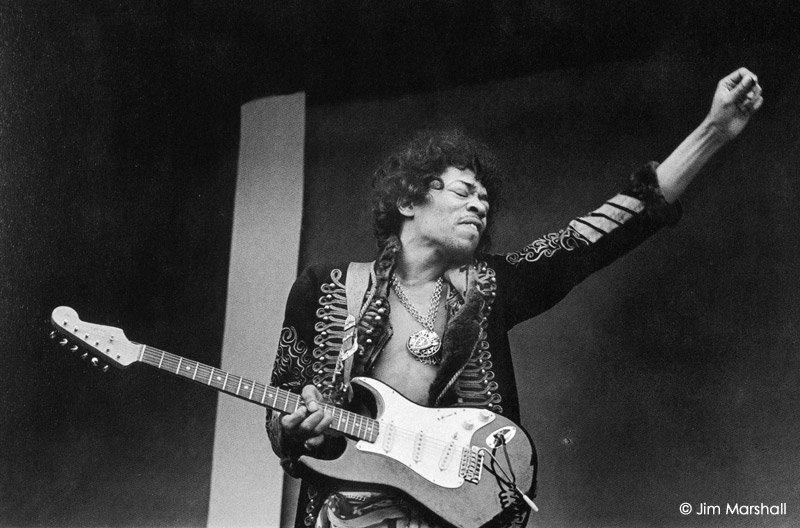 A close friend came up with a novel idea. She felt that people should attend their own funerals while they are still alive. The idea was that one should be able to hear what your closest friends, lovers and family (and in Jim's case, the media) think of you while you're still alive to appreciate it. Or perhaps to hate it. It's too bad Jim never had this opportunity to know how deeply he was appreciated; not only as a great photographer, but also as one of the most unique individuals to ever pick up a camera.
The good, the bad and the ugly, so to speak, have been written about him. I have decided to quote some of the comments written about Jim. The comments come from blogs and excerpts from interviews I've personally conducted about Jim Marshall, with people who knew him well.
**Excerpts from an interview done with Samy Kamienowic, owner and founder of Samy's Camera and longtime friend of Jim Marshall.
A close friend came up with a novel idea. She felt that people should attend their own funerals while they are still alive. The idea was that one should be able to hear what your closest friends, lovers and family (and in Jim's case, the media) think of you while you're still alive to appreciate it. Or perhaps to hate it. It's too bad Jim never had this opportunity to know how deeply he was appreciated; not only as a great photographer, but also as one of the most unique individuals to ever pick up a camera.
The good, the bad and the ugly, so to speak, have been written about him. I have decided to quote some of the comments written about Jim. The comments come from blogs and excerpts from interviews I've personally conducted about Jim Marshall, with people who knew him well.
**Excerpts from an interview done with Samy Kamienowic, owner and founder of Samy's Camera and longtime friend of Jim Marshall.
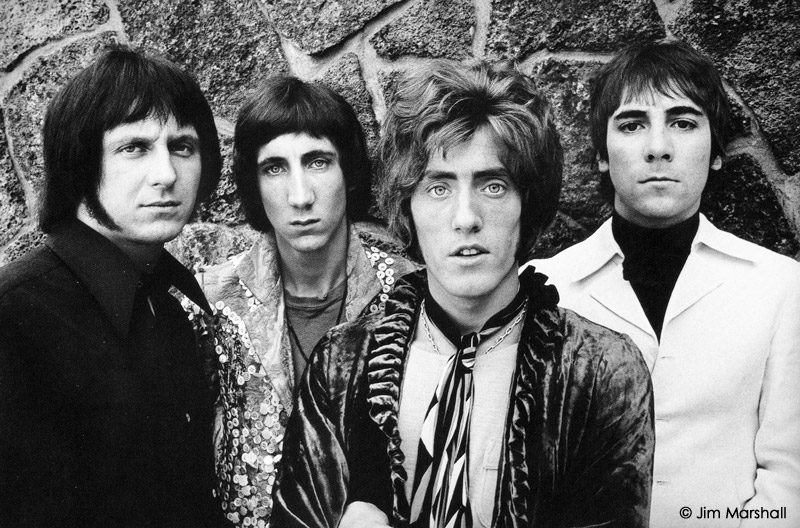 Q You've known so many great photographers in your life. What distinguishes Jim Marshall from other photographers? What makes him unique?
A "I think his style, attitude. He was very independent. He had a gruff exterior but he was really a good guy beneath all that. I know, for a fact, he helped in a lot of causes that he was involved in. Much of this was never publicized. He donated a lot of his art to a number of different causes.
"I was amazed by his memory. He could go back forty years or more, and know where he shot every picture, exactly where it was, names, the F-stop, the focal length of the lens, the film that he used. It was just amazing. Without notes, he could remember all this. He was a lot of fun to be with. He was strictly a film guy. He just loved his Leicas. He was an iconic kind of guy. We're going to miss him. Whatever bargain we made with him, he lived up to it."
**Excerpt from an interview with David Fahey of the Fahey/Kline gallery, Los Angeles. David had a long term and personal working relationship with Jim, selling and representing his art work. He also helped to edit and publish two of Jim's early books.
Q Right off the top of your head, what comes to mind when you think of Jim Marshall? What's the first thing that comes to you?
Q You've known so many great photographers in your life. What distinguishes Jim Marshall from other photographers? What makes him unique?
A "I think his style, attitude. He was very independent. He had a gruff exterior but he was really a good guy beneath all that. I know, for a fact, he helped in a lot of causes that he was involved in. Much of this was never publicized. He donated a lot of his art to a number of different causes.
"I was amazed by his memory. He could go back forty years or more, and know where he shot every picture, exactly where it was, names, the F-stop, the focal length of the lens, the film that he used. It was just amazing. Without notes, he could remember all this. He was a lot of fun to be with. He was strictly a film guy. He just loved his Leicas. He was an iconic kind of guy. We're going to miss him. Whatever bargain we made with him, he lived up to it."
**Excerpt from an interview with David Fahey of the Fahey/Kline gallery, Los Angeles. David had a long term and personal working relationship with Jim, selling and representing his art work. He also helped to edit and publish two of Jim's early books.
Q Right off the top of your head, what comes to mind when you think of Jim Marshall? What's the first thing that comes to you?
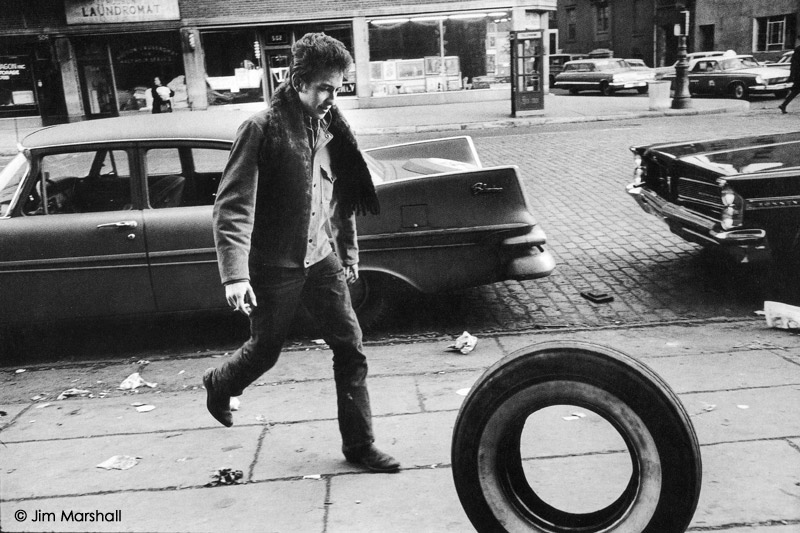 A "Johnny Cash flipping the bird, probably. . . It's playful, it's dramatic, and it's irreverent. It's all the things Jim was. I mean it's in your face, kind of indicative of his personality and demeanor."
Q What do you think distinguishes Jim's work? What was his fingerprint, so to speak, the quality that separated him from the pack?
A "Well, I think with all great portrait photographers, and Jim was, in a sense, a portrait photographer, is this sense of trust you have with your subjects. These subjects revealed themselves to Jim. They trusted him. They knew he was sincere, and as a consequence during the photo secession, he would make a great iconic portrait of them. I think of the Jimi Hendrix picture with his arm up. Or the Janis Joplin portraits, the real intimate ones, where you look into her soul. I've heard stories of people wanting to be photographed by Jim. They knew what kind of photographer he was, what he was capable of.
A "Johnny Cash flipping the bird, probably. . . It's playful, it's dramatic, and it's irreverent. It's all the things Jim was. I mean it's in your face, kind of indicative of his personality and demeanor."
Q What do you think distinguishes Jim's work? What was his fingerprint, so to speak, the quality that separated him from the pack?
A "Well, I think with all great portrait photographers, and Jim was, in a sense, a portrait photographer, is this sense of trust you have with your subjects. These subjects revealed themselves to Jim. They trusted him. They knew he was sincere, and as a consequence during the photo secession, he would make a great iconic portrait of them. I think of the Jimi Hendrix picture with his arm up. Or the Janis Joplin portraits, the real intimate ones, where you look into her soul. I've heard stories of people wanting to be photographed by Jim. They knew what kind of photographer he was, what he was capable of.
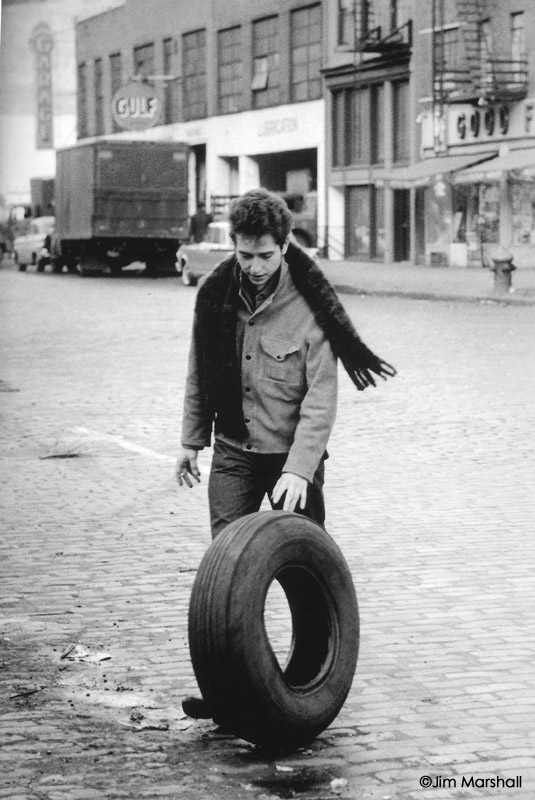 "He ran hot or cold. If he liked you, he was your best friend. If he didn't like you, the best thing to do was to stay out of his way. Jim and I got along great. He and I had a mutual respect for one another.
"He lived everyday fully. I mean, he had a complete and full life each day. That was just his nature".
**Excerpts from an interview done with Art Director Mike Salisbury. Mike is a legendary graphic designer who, at one time, was head art director of WEST magazine for the LA Times, from the late 1960's into the early 1970's. He went on to work for Rolling Stone magazine as head art director, during the magazines breakthrough years, while located in the Bay Area near San Francisco. He hired and worked with Jim Marshall on numerous occasions.
Q Mike, what defines a great photographer? So much of it has to do with a photographer's eye. What made Marshall's eye so important? How did he use his camera to help create his legacy?
A Jim said that he was a photojournalist. He really didn't see himself as a portrait photographer. He, as you know, was using Leica range finder cameras. He could feel by looking through the Leica's viewfinder, what he was taking a picture of. He would then record that person and that space as an event, carefully composed as a piece of history, as a record of time. There was always life. In every picture he ever took, there's life in it.
"He ran hot or cold. If he liked you, he was your best friend. If he didn't like you, the best thing to do was to stay out of his way. Jim and I got along great. He and I had a mutual respect for one another.
"He lived everyday fully. I mean, he had a complete and full life each day. That was just his nature".
**Excerpts from an interview done with Art Director Mike Salisbury. Mike is a legendary graphic designer who, at one time, was head art director of WEST magazine for the LA Times, from the late 1960's into the early 1970's. He went on to work for Rolling Stone magazine as head art director, during the magazines breakthrough years, while located in the Bay Area near San Francisco. He hired and worked with Jim Marshall on numerous occasions.
Q Mike, what defines a great photographer? So much of it has to do with a photographer's eye. What made Marshall's eye so important? How did he use his camera to help create his legacy?
A Jim said that he was a photojournalist. He really didn't see himself as a portrait photographer. He, as you know, was using Leica range finder cameras. He could feel by looking through the Leica's viewfinder, what he was taking a picture of. He would then record that person and that space as an event, carefully composed as a piece of history, as a record of time. There was always life. In every picture he ever took, there's life in it.
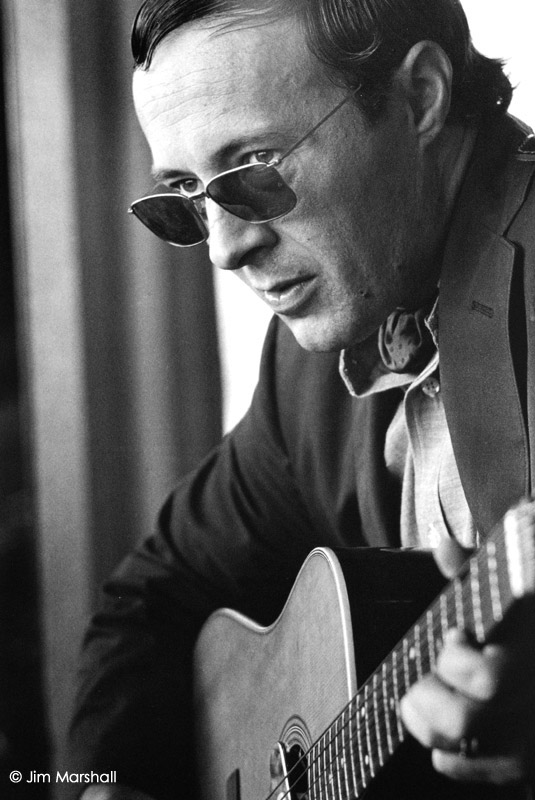 He worked completely differently than Annie Leibovitz...she shot a lot of film and really worked and schmoozed with the people. Jim was "kinda there" when there wasn't time to talk, to witness the event, like in the photo of Carlos Santana. It was taken during a street concert. You can see all of San Francisco behind him in the crowd. So he got Santana, he got the moment, and he got the event.
You can take a picture, but unless the elements are all in the right place and in order, to tell the story, it doesn't work. Jim Marshall's photo of Carlos looks like a rock 'n' roll painting. The great photo of Bob Dylan rolling the tire down the street is another example. He could get people sitting still or performing. His pictures are a chronicle of a generation, of the 1960's, and the most important part of that time, which was the music.
**Excerpts from an interview done with George Green, senior manager for Samy's camera, who knew Jim well when he lived in San Francisco, and later while working in Los Angeles.
Q What kind of guy was Jim Marshall?
A "Not necessarily a happy-go-lucky type of guy, but the kind of guy who liked to drink and go to bars a little bit, look for girls all the time. We used to hang out and do that together. We got thrown out of a lot of places in San Francisco. Jim used to get excited.
"But he was a nice guy, an interesting person. He knew a lot of people, knew a lot of celebrities, and he was a very creative individual, a very creative photographer."
He worked completely differently than Annie Leibovitz...she shot a lot of film and really worked and schmoozed with the people. Jim was "kinda there" when there wasn't time to talk, to witness the event, like in the photo of Carlos Santana. It was taken during a street concert. You can see all of San Francisco behind him in the crowd. So he got Santana, he got the moment, and he got the event.
You can take a picture, but unless the elements are all in the right place and in order, to tell the story, it doesn't work. Jim Marshall's photo of Carlos looks like a rock 'n' roll painting. The great photo of Bob Dylan rolling the tire down the street is another example. He could get people sitting still or performing. His pictures are a chronicle of a generation, of the 1960's, and the most important part of that time, which was the music.
**Excerpts from an interview done with George Green, senior manager for Samy's camera, who knew Jim well when he lived in San Francisco, and later while working in Los Angeles.
Q What kind of guy was Jim Marshall?
A "Not necessarily a happy-go-lucky type of guy, but the kind of guy who liked to drink and go to bars a little bit, look for girls all the time. We used to hang out and do that together. We got thrown out of a lot of places in San Francisco. Jim used to get excited.
"But he was a nice guy, an interesting person. He knew a lot of people, knew a lot of celebrities, and he was a very creative individual, a very creative photographer."
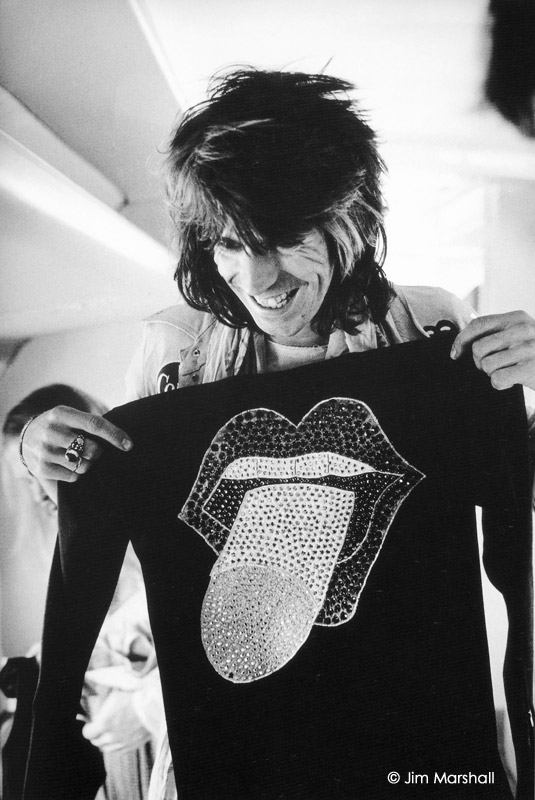 Q What made Marshall different, as a photographer?
A Jim was very sensitive to people. He was an excellent street photographer. With his Leica he worked quietly. He was able to capture what he saw. He was like "one of the boys." He could fit into almost any situation and come away with great photographs.
He was also very helpful to a lot of people. He never felt competition between himself and other photographers. He always helped them out. He always worked with them. His bark was rough and all those things. He would scare you, but he really wasn't like that all the time.
** The following excerpts were taken from various Blogs written about Jim Marshall:
Chronicle books blog: Michelle Dunn Marsh/ Senior Editor .."Jim said that his photographs are his children", and I believe that to be true. Marianne Campbell Hockenberry's blog....Jim Marshall was one of the first photographers I met when I started representing photographers in 1989. We became fast friends, and would often meet for lunch or drinks.
Q What made Marshall different, as a photographer?
A Jim was very sensitive to people. He was an excellent street photographer. With his Leica he worked quietly. He was able to capture what he saw. He was like "one of the boys." He could fit into almost any situation and come away with great photographs.
He was also very helpful to a lot of people. He never felt competition between himself and other photographers. He always helped them out. He always worked with them. His bark was rough and all those things. He would scare you, but he really wasn't like that all the time.
** The following excerpts were taken from various Blogs written about Jim Marshall:
Chronicle books blog: Michelle Dunn Marsh/ Senior Editor .."Jim said that his photographs are his children", and I believe that to be true. Marianne Campbell Hockenberry's blog....Jim Marshall was one of the first photographers I met when I started representing photographers in 1989. We became fast friends, and would often meet for lunch or drinks. 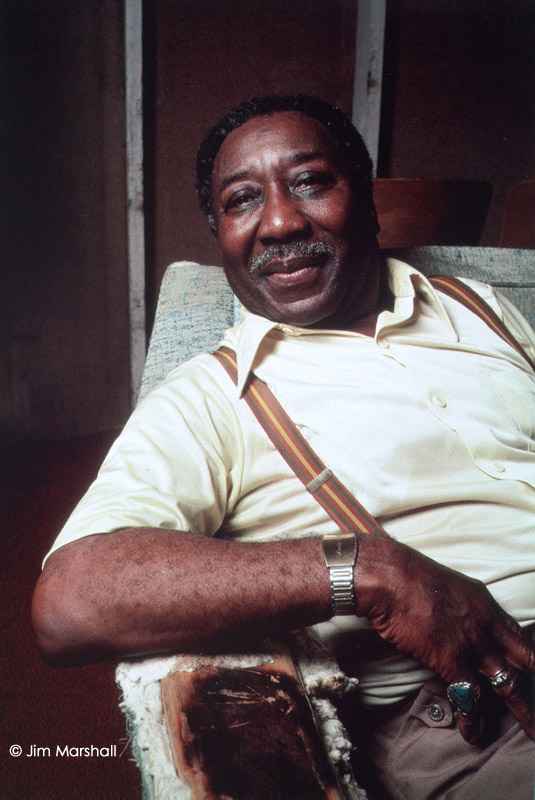 I soon realized that he was certifiably insane. We would be sitting at lunch and he would pull out a gun, or start some tirade filled with profanity, slurs, you name it. But somehow, he was still so damn lovable. He had the most amazing stories of his life. He had access to the phenomenal musicians he photographed because they trusted him and they felt he was one of them.
Rock & Roll Daily: Neal Preston..He carried with him, at all times, a sense of supreme and undeniable confidence...the confidence that came with knowing that he was THE master of his chosen craft. This is a HUGE loss for all of us and I'm not sure the news will ever really sink into my soul.
***Editors note..Books by Jim Marshall: NOT FADE AWAY, JIM MARSHALL JAZZ, PROOF BY JIM MARSHALL, TRUST, MATCH PRINTS
I soon realized that he was certifiably insane. We would be sitting at lunch and he would pull out a gun, or start some tirade filled with profanity, slurs, you name it. But somehow, he was still so damn lovable. He had the most amazing stories of his life. He had access to the phenomenal musicians he photographed because they trusted him and they felt he was one of them.
Rock & Roll Daily: Neal Preston..He carried with him, at all times, a sense of supreme and undeniable confidence...the confidence that came with knowing that he was THE master of his chosen craft. This is a HUGE loss for all of us and I'm not sure the news will ever really sink into my soul.
***Editors note..Books by Jim Marshall: NOT FADE AWAY, JIM MARSHALL JAZZ, PROOF BY JIM MARSHALL, TRUST, MATCH PRINTS
 whose work helped to define an entire generation of musicians, as well as the tone and mood of America during the 1960's through the 21st century. Jim Marshall, the legendary rock 'n' roll photographer, was truly bigger than life.
Marshall was the real thing. He was an uncompromising photographer who brought an intense, sophisticated vision to his photographs. He had a deep respect for the people he photographed and the music they produced, whether it was the brilliant jazz musician Miles Davis, or our own generation's most prolific poet, Bob Dylan. His photographs of the British bands, the Beatles, the Rolling Stones and the Who are definitive and profoundly memorable. It is reported that he had over 500 album covers to his credit.
It is not widely known, but he also photographed the political hurricanes of the 1960's. He accomplished sensitive work documenting the Black Panthers and others involved in the civil rights movement of the early 1960's. He also photographed the poverty of rural Appalachia.
whose work helped to define an entire generation of musicians, as well as the tone and mood of America during the 1960's through the 21st century. Jim Marshall, the legendary rock 'n' roll photographer, was truly bigger than life.
Marshall was the real thing. He was an uncompromising photographer who brought an intense, sophisticated vision to his photographs. He had a deep respect for the people he photographed and the music they produced, whether it was the brilliant jazz musician Miles Davis, or our own generation's most prolific poet, Bob Dylan. His photographs of the British bands, the Beatles, the Rolling Stones and the Who are definitive and profoundly memorable. It is reported that he had over 500 album covers to his credit.
It is not widely known, but he also photographed the political hurricanes of the 1960's. He accomplished sensitive work documenting the Black Panthers and others involved in the civil rights movement of the early 1960's. He also photographed the poverty of rural Appalachia.
 Jim Marshall passed away on March 24, 2010 in New York City, while promoting a new book. Sadly, we have lost another great photographer. He was from a generation of amazing film photographers, many whose work found expression in black and white film emulsions. Jim Marshall is gone, but he will never be forgotten. Marshall would say of his work that he thought of himself as a photojournalist. He requested, and almost always received, total access to the musicians he photographed. He never fashioned himself as a celebrity photographer, although he worked with some of the most famous, highly successful individuals in the music world. He was schooled in the down the line, black-and-white "moment of truth" as photographer Cartier Bresson would coin the classic phrase "The Decisive Moment".
With a highly focused eye, he photographed with Leica 35 mm film cameras, mostly shooting Tri-x film, carefully filling his frame the way a fine artist renders every inch of their composition to support their unique vision and purpose. He rarely cropped his photographs, believing instead in the power of the full-frame image. Technically, he was a master with 35mm black and white photography. Whether he was working in extreme low light levels with black jazz musicians, or bright sunlight, blazing on outdoor concert stages, his photographs were beautifully executed. He was demanding of his darkroom assistants; the ones who developed his film, made exquisite enlargements for exhibitions and provided images for the multitude of magazines and books in which his work would later appear.
Jim Marshall passed away on March 24, 2010 in New York City, while promoting a new book. Sadly, we have lost another great photographer. He was from a generation of amazing film photographers, many whose work found expression in black and white film emulsions. Jim Marshall is gone, but he will never be forgotten. Marshall would say of his work that he thought of himself as a photojournalist. He requested, and almost always received, total access to the musicians he photographed. He never fashioned himself as a celebrity photographer, although he worked with some of the most famous, highly successful individuals in the music world. He was schooled in the down the line, black-and-white "moment of truth" as photographer Cartier Bresson would coin the classic phrase "The Decisive Moment".
With a highly focused eye, he photographed with Leica 35 mm film cameras, mostly shooting Tri-x film, carefully filling his frame the way a fine artist renders every inch of their composition to support their unique vision and purpose. He rarely cropped his photographs, believing instead in the power of the full-frame image. Technically, he was a master with 35mm black and white photography. Whether he was working in extreme low light levels with black jazz musicians, or bright sunlight, blazing on outdoor concert stages, his photographs were beautifully executed. He was demanding of his darkroom assistants; the ones who developed his film, made exquisite enlargements for exhibitions and provided images for the multitude of magazines and books in which his work would later appear.
 There's a story I heard once about Marshall before we met and became friends. I never forgot it. He had done a major shoot for a record company, including the key art used for the album cover and supporting back up images of the musicians. He was unhappy with how the art director was using his pictures. Marshall went into the art director's office, carrying a loaded handgun into the meeting with him. He told the art director that if he didn't use his photographs properly, his life hung in the balance.
Knowing Jim, I'm sure this was a passionate, dramatic, theatrical gesture on his part. He probably intended to emphasize how important it was to him that his pictures were respected, and that the designs brought out the best of their potential. Jim would never have actually fired his weapon, but the incident illustrates how emotionally connected he was to his work. It was paramount to him that a photographer had the right to have their work used with respect and integrity. He fought many battles to ensure that his photographs were properly used. He championed the concept that photographers should own their own work and maintain the copyright to their images, even when on assignment. He sued many people through his lifetime for publishing his photographs without his permission.
There's a story I heard once about Marshall before we met and became friends. I never forgot it. He had done a major shoot for a record company, including the key art used for the album cover and supporting back up images of the musicians. He was unhappy with how the art director was using his pictures. Marshall went into the art director's office, carrying a loaded handgun into the meeting with him. He told the art director that if he didn't use his photographs properly, his life hung in the balance.
Knowing Jim, I'm sure this was a passionate, dramatic, theatrical gesture on his part. He probably intended to emphasize how important it was to him that his pictures were respected, and that the designs brought out the best of their potential. Jim would never have actually fired his weapon, but the incident illustrates how emotionally connected he was to his work. It was paramount to him that a photographer had the right to have their work used with respect and integrity. He fought many battles to ensure that his photographs were properly used. He championed the concept that photographers should own their own work and maintain the copyright to their images, even when on assignment. He sued many people through his lifetime for publishing his photographs without his permission. A close friend came up with a novel idea. She felt that people should attend their own funerals while they are still alive. The idea was that one should be able to hear what your closest friends, lovers and family (and in Jim's case, the media) think of you while you're still alive to appreciate it. Or perhaps to hate it. It's too bad Jim never had this opportunity to know how deeply he was appreciated; not only as a great photographer, but also as one of the most unique individuals to ever pick up a camera.
The good, the bad and the ugly, so to speak, have been written about him. I have decided to quote some of the comments written about Jim. The comments come from blogs and excerpts from interviews I've personally conducted about Jim Marshall, with people who knew him well.
**Excerpts from an interview done with Samy Kamienowic, owner and founder of Samy's Camera and longtime friend of Jim Marshall.
A close friend came up with a novel idea. She felt that people should attend their own funerals while they are still alive. The idea was that one should be able to hear what your closest friends, lovers and family (and in Jim's case, the media) think of you while you're still alive to appreciate it. Or perhaps to hate it. It's too bad Jim never had this opportunity to know how deeply he was appreciated; not only as a great photographer, but also as one of the most unique individuals to ever pick up a camera.
The good, the bad and the ugly, so to speak, have been written about him. I have decided to quote some of the comments written about Jim. The comments come from blogs and excerpts from interviews I've personally conducted about Jim Marshall, with people who knew him well.
**Excerpts from an interview done with Samy Kamienowic, owner and founder of Samy's Camera and longtime friend of Jim Marshall.
 Q You've known so many great photographers in your life. What distinguishes Jim Marshall from other photographers? What makes him unique?
A "I think his style, attitude. He was very independent. He had a gruff exterior but he was really a good guy beneath all that. I know, for a fact, he helped in a lot of causes that he was involved in. Much of this was never publicized. He donated a lot of his art to a number of different causes.
"I was amazed by his memory. He could go back forty years or more, and know where he shot every picture, exactly where it was, names, the F-stop, the focal length of the lens, the film that he used. It was just amazing. Without notes, he could remember all this. He was a lot of fun to be with. He was strictly a film guy. He just loved his Leicas. He was an iconic kind of guy. We're going to miss him. Whatever bargain we made with him, he lived up to it."
**Excerpt from an interview with David Fahey of the Fahey/Kline gallery, Los Angeles. David had a long term and personal working relationship with Jim, selling and representing his art work. He also helped to edit and publish two of Jim's early books.
Q Right off the top of your head, what comes to mind when you think of Jim Marshall? What's the first thing that comes to you?
Q You've known so many great photographers in your life. What distinguishes Jim Marshall from other photographers? What makes him unique?
A "I think his style, attitude. He was very independent. He had a gruff exterior but he was really a good guy beneath all that. I know, for a fact, he helped in a lot of causes that he was involved in. Much of this was never publicized. He donated a lot of his art to a number of different causes.
"I was amazed by his memory. He could go back forty years or more, and know where he shot every picture, exactly where it was, names, the F-stop, the focal length of the lens, the film that he used. It was just amazing. Without notes, he could remember all this. He was a lot of fun to be with. He was strictly a film guy. He just loved his Leicas. He was an iconic kind of guy. We're going to miss him. Whatever bargain we made with him, he lived up to it."
**Excerpt from an interview with David Fahey of the Fahey/Kline gallery, Los Angeles. David had a long term and personal working relationship with Jim, selling and representing his art work. He also helped to edit and publish two of Jim's early books.
Q Right off the top of your head, what comes to mind when you think of Jim Marshall? What's the first thing that comes to you?
 A "Johnny Cash flipping the bird, probably. . . It's playful, it's dramatic, and it's irreverent. It's all the things Jim was. I mean it's in your face, kind of indicative of his personality and demeanor."
Q What do you think distinguishes Jim's work? What was his fingerprint, so to speak, the quality that separated him from the pack?
A "Well, I think with all great portrait photographers, and Jim was, in a sense, a portrait photographer, is this sense of trust you have with your subjects. These subjects revealed themselves to Jim. They trusted him. They knew he was sincere, and as a consequence during the photo secession, he would make a great iconic portrait of them. I think of the Jimi Hendrix picture with his arm up. Or the Janis Joplin portraits, the real intimate ones, where you look into her soul. I've heard stories of people wanting to be photographed by Jim. They knew what kind of photographer he was, what he was capable of.
A "Johnny Cash flipping the bird, probably. . . It's playful, it's dramatic, and it's irreverent. It's all the things Jim was. I mean it's in your face, kind of indicative of his personality and demeanor."
Q What do you think distinguishes Jim's work? What was his fingerprint, so to speak, the quality that separated him from the pack?
A "Well, I think with all great portrait photographers, and Jim was, in a sense, a portrait photographer, is this sense of trust you have with your subjects. These subjects revealed themselves to Jim. They trusted him. They knew he was sincere, and as a consequence during the photo secession, he would make a great iconic portrait of them. I think of the Jimi Hendrix picture with his arm up. Or the Janis Joplin portraits, the real intimate ones, where you look into her soul. I've heard stories of people wanting to be photographed by Jim. They knew what kind of photographer he was, what he was capable of.
 "He ran hot or cold. If he liked you, he was your best friend. If he didn't like you, the best thing to do was to stay out of his way. Jim and I got along great. He and I had a mutual respect for one another.
"He lived everyday fully. I mean, he had a complete and full life each day. That was just his nature".
**Excerpts from an interview done with Art Director Mike Salisbury. Mike is a legendary graphic designer who, at one time, was head art director of WEST magazine for the LA Times, from the late 1960's into the early 1970's. He went on to work for Rolling Stone magazine as head art director, during the magazines breakthrough years, while located in the Bay Area near San Francisco. He hired and worked with Jim Marshall on numerous occasions.
Q Mike, what defines a great photographer? So much of it has to do with a photographer's eye. What made Marshall's eye so important? How did he use his camera to help create his legacy?
A Jim said that he was a photojournalist. He really didn't see himself as a portrait photographer. He, as you know, was using Leica range finder cameras. He could feel by looking through the Leica's viewfinder, what he was taking a picture of. He would then record that person and that space as an event, carefully composed as a piece of history, as a record of time. There was always life. In every picture he ever took, there's life in it.
"He ran hot or cold. If he liked you, he was your best friend. If he didn't like you, the best thing to do was to stay out of his way. Jim and I got along great. He and I had a mutual respect for one another.
"He lived everyday fully. I mean, he had a complete and full life each day. That was just his nature".
**Excerpts from an interview done with Art Director Mike Salisbury. Mike is a legendary graphic designer who, at one time, was head art director of WEST magazine for the LA Times, from the late 1960's into the early 1970's. He went on to work for Rolling Stone magazine as head art director, during the magazines breakthrough years, while located in the Bay Area near San Francisco. He hired and worked with Jim Marshall on numerous occasions.
Q Mike, what defines a great photographer? So much of it has to do with a photographer's eye. What made Marshall's eye so important? How did he use his camera to help create his legacy?
A Jim said that he was a photojournalist. He really didn't see himself as a portrait photographer. He, as you know, was using Leica range finder cameras. He could feel by looking through the Leica's viewfinder, what he was taking a picture of. He would then record that person and that space as an event, carefully composed as a piece of history, as a record of time. There was always life. In every picture he ever took, there's life in it.
 He worked completely differently than Annie Leibovitz...she shot a lot of film and really worked and schmoozed with the people. Jim was "kinda there" when there wasn't time to talk, to witness the event, like in the photo of Carlos Santana. It was taken during a street concert. You can see all of San Francisco behind him in the crowd. So he got Santana, he got the moment, and he got the event.
You can take a picture, but unless the elements are all in the right place and in order, to tell the story, it doesn't work. Jim Marshall's photo of Carlos looks like a rock 'n' roll painting. The great photo of Bob Dylan rolling the tire down the street is another example. He could get people sitting still or performing. His pictures are a chronicle of a generation, of the 1960's, and the most important part of that time, which was the music.
**Excerpts from an interview done with George Green, senior manager for Samy's camera, who knew Jim well when he lived in San Francisco, and later while working in Los Angeles.
Q What kind of guy was Jim Marshall?
A "Not necessarily a happy-go-lucky type of guy, but the kind of guy who liked to drink and go to bars a little bit, look for girls all the time. We used to hang out and do that together. We got thrown out of a lot of places in San Francisco. Jim used to get excited.
"But he was a nice guy, an interesting person. He knew a lot of people, knew a lot of celebrities, and he was a very creative individual, a very creative photographer."
He worked completely differently than Annie Leibovitz...she shot a lot of film and really worked and schmoozed with the people. Jim was "kinda there" when there wasn't time to talk, to witness the event, like in the photo of Carlos Santana. It was taken during a street concert. You can see all of San Francisco behind him in the crowd. So he got Santana, he got the moment, and he got the event.
You can take a picture, but unless the elements are all in the right place and in order, to tell the story, it doesn't work. Jim Marshall's photo of Carlos looks like a rock 'n' roll painting. The great photo of Bob Dylan rolling the tire down the street is another example. He could get people sitting still or performing. His pictures are a chronicle of a generation, of the 1960's, and the most important part of that time, which was the music.
**Excerpts from an interview done with George Green, senior manager for Samy's camera, who knew Jim well when he lived in San Francisco, and later while working in Los Angeles.
Q What kind of guy was Jim Marshall?
A "Not necessarily a happy-go-lucky type of guy, but the kind of guy who liked to drink and go to bars a little bit, look for girls all the time. We used to hang out and do that together. We got thrown out of a lot of places in San Francisco. Jim used to get excited.
"But he was a nice guy, an interesting person. He knew a lot of people, knew a lot of celebrities, and he was a very creative individual, a very creative photographer."
 Q What made Marshall different, as a photographer?
A Jim was very sensitive to people. He was an excellent street photographer. With his Leica he worked quietly. He was able to capture what he saw. He was like "one of the boys." He could fit into almost any situation and come away with great photographs.
He was also very helpful to a lot of people. He never felt competition between himself and other photographers. He always helped them out. He always worked with them. His bark was rough and all those things. He would scare you, but he really wasn't like that all the time.
** The following excerpts were taken from various Blogs written about Jim Marshall:
Chronicle books blog: Michelle Dunn Marsh/ Senior Editor .."Jim said that his photographs are his children", and I believe that to be true. Marianne Campbell Hockenberry's blog....Jim Marshall was one of the first photographers I met when I started representing photographers in 1989. We became fast friends, and would often meet for lunch or drinks.
Q What made Marshall different, as a photographer?
A Jim was very sensitive to people. He was an excellent street photographer. With his Leica he worked quietly. He was able to capture what he saw. He was like "one of the boys." He could fit into almost any situation and come away with great photographs.
He was also very helpful to a lot of people. He never felt competition between himself and other photographers. He always helped them out. He always worked with them. His bark was rough and all those things. He would scare you, but he really wasn't like that all the time.
** The following excerpts were taken from various Blogs written about Jim Marshall:
Chronicle books blog: Michelle Dunn Marsh/ Senior Editor .."Jim said that his photographs are his children", and I believe that to be true. Marianne Campbell Hockenberry's blog....Jim Marshall was one of the first photographers I met when I started representing photographers in 1989. We became fast friends, and would often meet for lunch or drinks.  I soon realized that he was certifiably insane. We would be sitting at lunch and he would pull out a gun, or start some tirade filled with profanity, slurs, you name it. But somehow, he was still so damn lovable. He had the most amazing stories of his life. He had access to the phenomenal musicians he photographed because they trusted him and they felt he was one of them.
Rock & Roll Daily: Neal Preston..He carried with him, at all times, a sense of supreme and undeniable confidence...the confidence that came with knowing that he was THE master of his chosen craft. This is a HUGE loss for all of us and I'm not sure the news will ever really sink into my soul.
***Editors note..Books by Jim Marshall: NOT FADE AWAY, JIM MARSHALL JAZZ, PROOF BY JIM MARSHALL, TRUST, MATCH PRINTS
I soon realized that he was certifiably insane. We would be sitting at lunch and he would pull out a gun, or start some tirade filled with profanity, slurs, you name it. But somehow, he was still so damn lovable. He had the most amazing stories of his life. He had access to the phenomenal musicians he photographed because they trusted him and they felt he was one of them.
Rock & Roll Daily: Neal Preston..He carried with him, at all times, a sense of supreme and undeniable confidence...the confidence that came with knowing that he was THE master of his chosen craft. This is a HUGE loss for all of us and I'm not sure the news will ever really sink into my soul.
***Editors note..Books by Jim Marshall: NOT FADE AWAY, JIM MARSHALL JAZZ, PROOF BY JIM MARSHALL, TRUST, MATCH PRINTS

